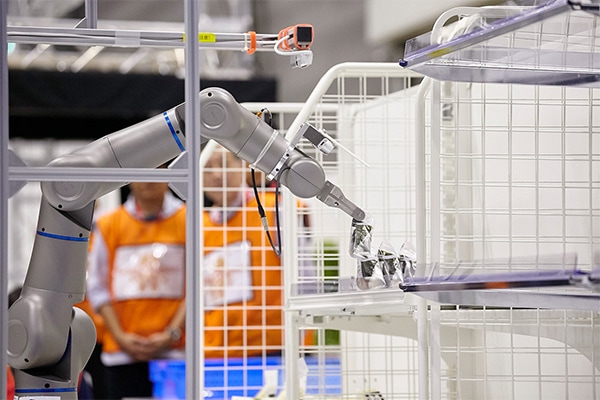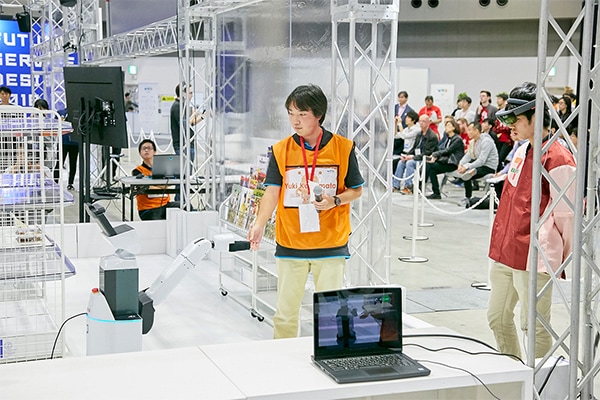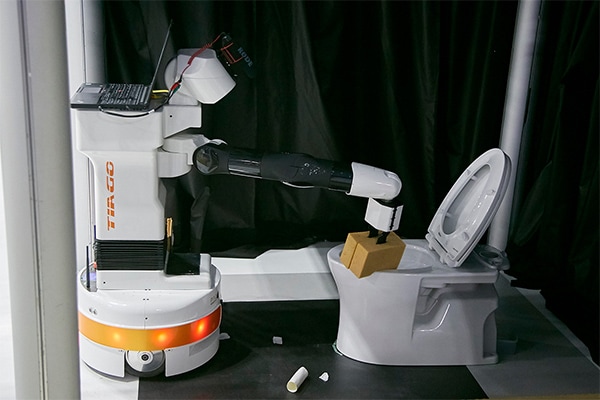Service
Future Convenience Store Challenge
- Partner Robot Challenge (Real Space)
- Future Convenience Store Challenge
Future Convenience
Store Challenge
Making robots to complete tasks such as shelf-stocking and replenishment of multiple types of food products,
interaction with customers and staff, and cleaning restrooms
(Competition time for each team is listed in the description of the video.)
Outline
We expect participants to compete in all of the following three tasks.
Participants who wish to compete in either one or two tasks are also welcome.
Tasks
 1. Stock and Disposal Task
1. Stock and Disposal TaskPerform automatic replenishment of daily food products (rice balls, lunch boxes, etc.) and disposal of expired products.
 2. Customer Interaction Task
2. Customer Interaction TaskPropose and demonstrate near-future sophisticated customer service using robot technology.
 3. Restroom Cleaning Task
3. Restroom Cleaning TaskClean the toilet bowl and floor of the restroom
1. Stock and Disposal Task

This task uses the backyard area, the home area, the aisles and a display shelf. In the demonstration, following work is performed.
(1) Place the products stored in the container located at the home area into their designated places in the display shelf.
(2) Arrange the products already on the display shelf and take the disposal items back to the home area.
Flow of the Competition
Each team will have 15 minutes. The order of competition will be as follows.
- 1. Reform Time
-
Participants will set up the infrastructure, replace the shelf and so on, as necessary.
Allowed works within the time are the following:- Set up own infrastructure in the store
- Replace the shelf brought by the team
- Add own infrastructure to the products
- 2. Setup Time
-
The chief judge will announce 6 products to be disposed.
- 3. Demonstration of Stocking Products and Disposing of Expired Products
-
- The robot will pick up 6 kinds, 8 products and stock them in their designated locations on the display shelf.
- There are already arranged 6 kinds, 12 products on the display shelf. The robot will check the expiry dates printed on the reverse side of the products, and remove the applicable products. Also, the robot must arrange the remaining products in their designated locations.
- The robot will take the disposal products to the home station.
*Allocation of time can be freely decided by each team.
2. Customer Interaction Task

Participants will freely develop a scenario involving customer interaction, and demonstrate it within the time allocated.
Flow of competition
Each team will have 15 minutes. The competition will be carried out in the following order:
- (1) Reform Time
-
Participants will set up infrastructure and replace the shelf, etc.
Allowed works within the time are the following:- Work of setting up own infrastructure in the store
- Work of replacing display shelf, table for cash register, etc. to own ones.
Participants will set the products and robot. Participants can set up the initial position of the robot and products inside the store set.
- (2) Presentation
-
Participants explain the outline and goal of their system.
(The presentation can be carried out during the demonstration.)
- (3) Customer Interaction Demonstration
-
Participants initiate the system. The participants are free to set their own task for the customer interaction work, and they give a demonstration of the system within the allotted time. Here are some examples of the type of demonstrations expected:
- Heating up a lunch box and putting it in a bag.
- Receiving orders from a staff member for hot snack items or cigarettes, and retrieving the items.
- Checking gender and age of customers
- Recommending products
- Preventing shoplifting
- Assisting seniors, people who can’t speak Japanese, wheelchair users, and so on
- Customer support
*These are only a few examples of customer interaction not services that need to be implemented.
*The participants will provide the customers for the demonstration scenario.
*Allocation of time can be freely decided by each team.
3. Restroom Cleaning Task

Carry out the following work in a demonstration
- (1) Clean simulated urine off the toilet (top surface, sides, underside of the seat) as well as the floor around the toilet.
*Not necessary to clean inside the toilet bowl
- (2) Remove any garbage on the floor (toilet paper, toilet paper tubes, paper cups)
Flow of Competition
Each team will have 15 minutes. The competition will be carried out in the following order.
- 1. Reform time
-
Participants will install their infrastructure in the infrastructure area. Then, participants will store and adjust the toilet while also setting up their mobile robot. The initial location of the mobile robot should be outside the restroom.
- 2. Setup Time
-
The judge will place the garbage and spread simulated urine.
- 3. Cleaning Demonstration
-
1) Simulated urine
An amount of 300 ml of simulated urine will be sprayed into the toilet bowl using a water spraying device (peeing boy statue) while the toilet seat is up, which results in splashing the surrounding areas.2) Cleaning Garbage
There will be five pieces of garbage including three scraps of toilet paper (maximum length about 5cm), one toilet paper roll tube, and one paper cup, placed on the floor. The items will be placed after the simulated urine is released.
*Allocation of time can be freely decided by each team.
- Partner Robot Challenge (Real Space)
- Future Convenience Store Challenge
